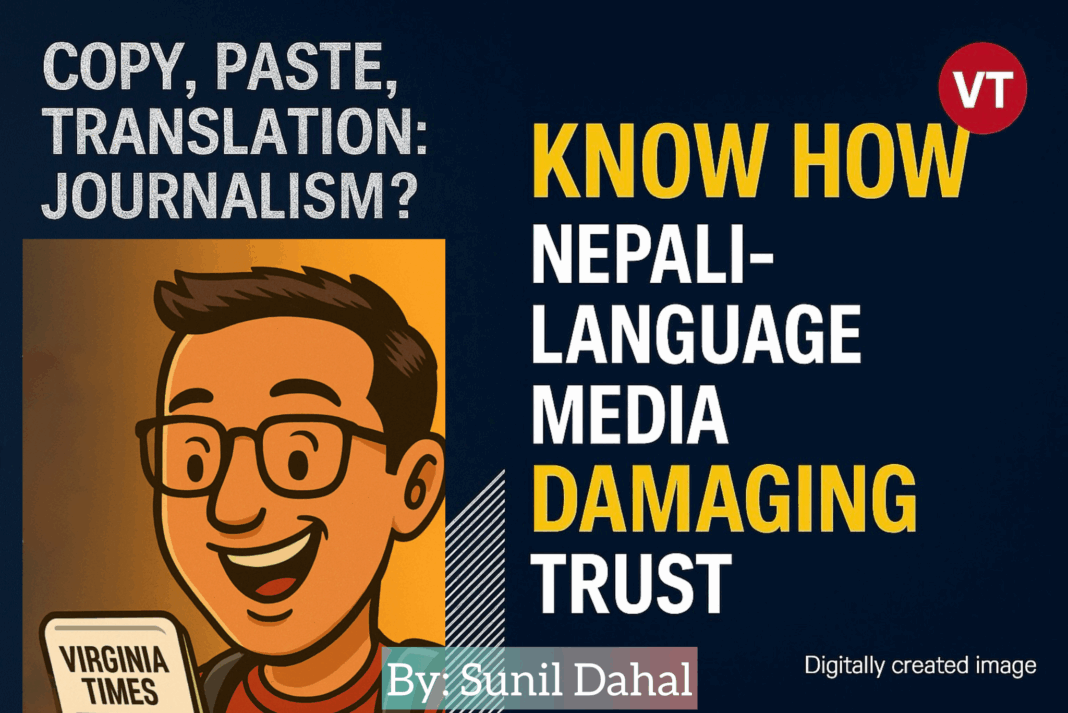NEED TO KNOW
- • Some Nepali-language media outlets in the U.S. operate part-time without editorial staff or newsroom structure
- • They often copy content from mainstream English media and translate it without verifying facts
- • Many use AI tools to rewrite or translate articles, leading to distorted or inaccurate information
- • Copyrighted images from global sources are used without permission or licensing
- • There’s no independent body reviewing their content due to language and regulatory gaps
Not All Are the Same—But Some Are Damaging Trust
Let’s be clear: not all Nepali-language news platforms in the U.S. are problematic. But a number of them are operating without professional standards. They copy news, mistranslate facts, publish rumors, and mislead the community. The result? Loss of trust, confusion, and reputational harm for Nepali journalism as a whole.Side Hustle, Not a Newsroom
Most of these outlets are run by individuals who do not work full-time in journalism. Their media work is often a side project alongside other jobs. That’s not necessarily bad—but it often means no proper editorial process, fact-checking, or accountability.Dependence on Mainstream English Media
Rather than reporting on their own, these platforms rely on mainstream U.S. outlets like CNN, The Washington Post, or Fox News. But they don’t link to these sources. They just translate English content into Nepali—sometimes using AI—and republish it as if it were their own work.Translation Without Verification
The problem isn’t translation itself. It’s blind translation. Headlines are taken out of context. Quotes are misunderstood. Sources are misrepresented. No one double-checks whether the information is accurate or current. Readers end up with confusion instead of clarity.AI Rewriting, No Human Review
To speed up production, some use AI tools to rewrite or translate articles. These tools lack cultural context, language nuance, or legal understanding. But because there’s no human editor reviewing the result, the published version often misleads or distorts the facts.Rampant Use of Copyrighted Images
These platforms regularly use images from Getty, Reuters, BBC, or other licensed photo sources without permission. Many don’t even watermark or credit images. This isn’t just unethical—it’s illegal. In the U.S., copyright lawsuits can carry serious penalties.
“Some Nepali platforms in the U.S. are essentially recycling others’ content with zero journalistic effort—but claiming full credit.”
No Regulatory Oversight Due to Language Barriers
Unlike mainstream U.S. news outlets, these Nepali-language platforms often operate under the radar. Because their content is in Nepali, it’s rarely reviewed by U.S. watchdogs, fact-checkers, or copyright enforcement bodies. This lack of oversight allows unethical behavior to flourish unchecked.Community Misled, Not Informed
Instead of informing the Nepali-American community, these outlets often confuse it. Sensational headlines, unverified immigration news, and political rumors spread quickly—especially on Facebook and YouTube—creating fear or false hope among readers.Role of Nepali Media Organizations in the U.S.
There are currently three main Nepali media associations in the U.S. But most of them are affiliated with political groups from Nepal. Rather than enforcing ethics or supporting professional standards, they often stay silent—or promote their allies. Independent Nepali journalists working with integrity receive little to no support.What Ethical Journalism Should Look Like
True journalism checks facts, cites sources, protects copyrights, and puts the reader first. Ethical journalists take responsibility for their mistakes and correct them publicly. Sadly, many Nepali outlets in the U.S. fail on all of these fronts.
“It’s not journalism if you copy, paste, and publish. Journalism demands integrity, transparency, and hard work.”
How to Improve
- Verify Facts: Always check with original sources before translating or publishing.
- Credit Your Sources: Link to or name the original authors and outlets.
- Use Legal Images: Respect copyright laws. Buy licenses or use royalty-free images.
- Invest in Training: Learn journalism ethics, media law, and writing techniques.
- Build Transparent Platforms: Show who runs your outlet. Share your editorial policies.
Final Thought
The Nepali diaspora in America is growing and evolving. It needs reliable, professional news in its own language. This means moving beyond hobbyist blogs and political PR. It’s time for Nepali-language media in the U.S. to grow up—and grow responsible.
Related Articles:
Follow Virginia Times for regular news updates. Stay informed with the latest headlines, breaking stories, and in-depth reporting from around the world.
Virginia Times – Your Trusted Media
Comments
More From Author
Freelance Writer
















